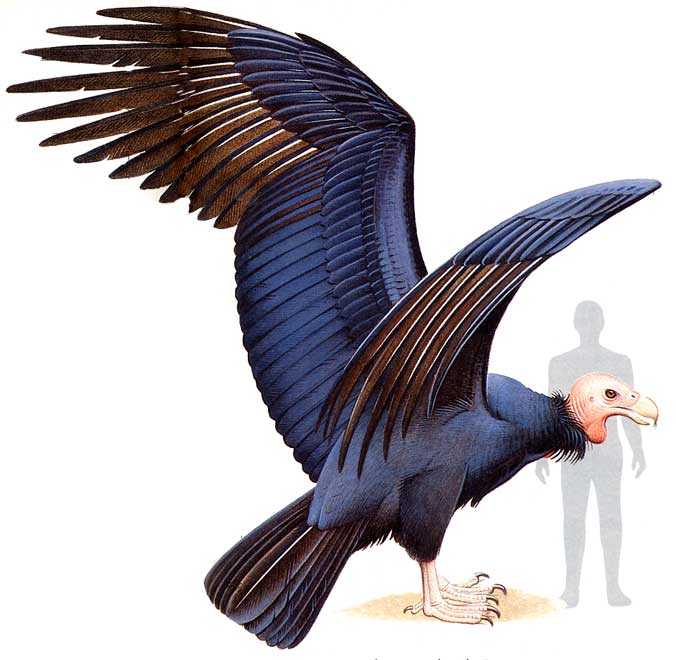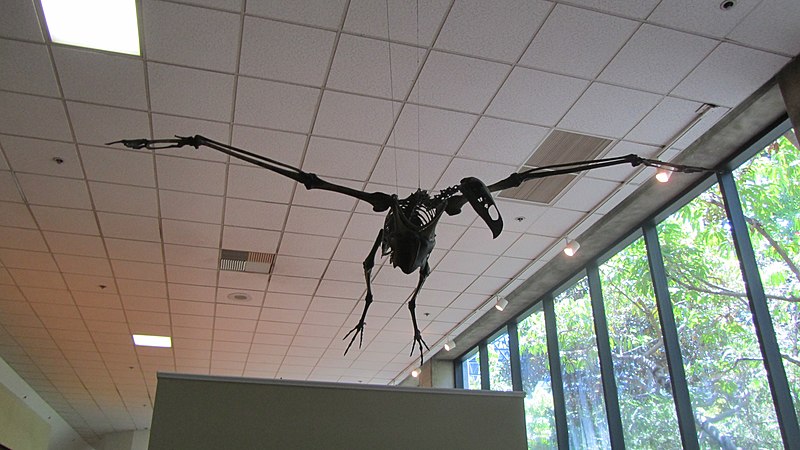Вы не зашли.
Объявление
"Давайте только проявлять больше внимания, терпимости и уважения к чужому мнению — вот и всё." — Gennadius.
— О размещении изображений на форуме, О рекламе на форуме
#151 10 February 2009 18:13:42
- Crazy Zoologist
- Гость
Re: Летающие великаны
Гарпагорнис отнесён к роду гарпагорнис, во всяком случае пока.
Да, походу речь идёт о A. morphnoides.
"The Little Eagle (Aquila morphnoides) is a very small eagle native to Australasia, measuring 45–55 cm (17–21.5 inches) in length and weighing 815 g (1.8 lb) – roughly the size of a Peregrine Falcon. It tends to inhabit open woodland, grassland and arid regions, shunning dense forest. It is a near relative of both the Palearctic Booted Eagle and, remarkably, the massive but now extinct Haast's Eagle of New Zealand."
#152 11 February 2009 18:30:25
- Crazy Zoologist
- Гость
Re: Летающие великаны
Как вы думаете, как выглядел гарпагорнис? Как орёл рода Aquila, к которому он близок или он был конвергентно схож с гарпией? И стоит ли его включать в род настоящих орлов?
#153 11 February 2009 18:33:45
- Спинозавр
- Без пяти минут зоолог

- Откуда: Тбилиси
- Зарегистрирован: 22 September 2008
- Сообщений: 1980
Re: Летающие великаны
Скорее он напоминал Гарпию.
Я думаю что его стоит включить в род Aquila.
Неактивен
#154 11 February 2009 18:54:42
- Crazy Zoologist
- Гость
Re: Летающие великаны
Да, я тоже думаю, что он скорее был похож на гарпиевидного венценосного орла, а не на увеличенного орла-карлика.
#155 20 February 2009 02:05:32
- Алекс
- Сан Саныч - Модератор

- Откуда: Юг Украины
- Зарегистрирован: 05 February 2008
- Сообщений: 24254
Re: Летающие великаны



" Из говна настоящий бульдог не получится, а вот силуэт слепить можно ". "Отрицать прошлое — это отрицать себя "
Неактивен
#156 20 February 2009 02:19:50
- Crazy Zoologist
- Гость
Re: Летающие великаны
5 см что-то маловато! У беркута и то больше - 3 дюйма!
#157 20 February 2009 03:16:20
- Crazy Zoologist
- Гость
Re: Летающие великаны
Странно, но длина плечевой кости у атрокса меньше чем у тигра если верить этим таблицам - http://shish02.livejournal.com/9343.html по атроксу и http://shish02.livejournal.com/10994.html#cutid1 по тигру.
#158 20 February 2009 15:55:41
- Arctodus-simus
- Модератор

- Откуда: Лукаморье
- Зарегистрирован: 15 October 2007
- Сообщений: 16362
Re: Летающие великаны
Чё-то ты, Артём, часто сообщения не в те темы вставляешь. К чему тут атрокс и тигр?
Doctrina multiplex , veritas una !
Неактивен
#159 20 February 2009 17:58:35
- Звероящер
- Модератор

- Откуда: Фрязино, Московская обл.
- Зарегистрирован: 13 April 2007
- Сообщений: 14912
Re: Летающие великаны
Crazy Zoologist :
5 см что-то маловато! У беркута и то больше - 3 дюйма!
это только когтевая фаланга без рогового чехла
Life is short, but snakes are long...
Неактивен
#160 22 February 2009 18:45:10
- Crazy Zoologist
- Гость
Re: Летающие великаны
Вика с какого-то перепугу поместила гарпагорниса в подсемейство гарпий. Как так, если уже выявили его генетическое родство с мелким орлом из Австралии. По-моему он должен быть по крайней мере в подсемействе канюковых. Что скажите?
#161 02 March 2009 21:13:17
- Юра
- Без пяти минут зоолог
- Зарегистрирован: 31 July 2008
- Сообщений: 10735
Re: Летающие великаны
В Перу нашли череп гигантского пелагорнитида возрастом 3 миллиона (видео):
http://www.vesti.ru/doc.html?id=258212
Неактивен
#162 15 September 2009 11:02:14
- Вурдалак Яшенька
- Любитель животных

- Зарегистрирован: 18 August 2009
- Сообщений: 283
Re: Летающие великаны
"Разум всегда приводит в ту точку, в которой ты назначаешь ему свидание" (о. Андрей Кураев)
Неактивен
#163 16 September 2009 00:50:34
- vladeymirom
- Гость
Re: Летающие великаны
Интересно, каким образом птицы вытеснили мелких птерозавров. И какие существа в те времена занимали нишу ночного неба (современных рукокрылых)?
#164 19 September 2009 19:45:07
- Алекс
- Сан Саныч - Модератор

- Откуда: Юг Украины
- Зарегистрирован: 05 February 2008
- Сообщений: 24254
Re: Летающие великаны
Остеодонторнис и альбатрос!

" Из говна настоящий бульдог не получится, а вот силуэт слепить можно ". "Отрицать прошлое — это отрицать себя "
Неактивен
#165 27 September 2009 10:10:45
- vjcrfkm
- Гость
Re: Летающие великаны
Crazy Zoologist :
P.S. Кстати, меня вот всегда интересовал вопрос, если курицу сбросить с высотного здания - она разобьётся? Вроде летать всё же умеет - через забор перемахивает, если очень постарается, а при падении с большой высоты крылья могут служить своего рода парашютом.
Садист ![]() ) Вот до чего научные эксперименты доводят
) Вот до чего научные эксперименты доводят ![]()
#166 06 December 2009 12:50:02
- Paleoman
- Гость
Re: Летающие великаны

#167 06 December 2009 20:35:21
- Miracinonyx
- Любитель животных

- Зарегистрирован: 05 December 2006
- Сообщений: 19226
Re: Летающие великаны
Это кто? Аргентавис величественный?
Неактивен
#168 06 December 2009 21:54:05
- Paleoman
- Гость
Re: Летающие великаны
Miracinonyx :
Это кто? Аргентавис величественный?
да. Он самый
#169 22 December 2009 20:34:30
- Алекс
- Сан Саныч - Модератор

- Откуда: Юг Украины
- Зарегистрирован: 05 February 2008
- Сообщений: 24254
Re: Летающие великаны
Buteogallus borrasi - гигантские ястребы из Кубы.
http://si-pddr.si.edu/dspace/bitstream/ … orrasi.pdf
" Из говна настоящий бульдог не получится, а вот силуэт слепить можно ". "Отрицать прошлое — это отрицать себя "
Неактивен
#170 22 December 2009 20:51:15
- Miracinonyx
- Любитель животных

- Зарегистрирован: 05 December 2006
- Сообщений: 19226
Re: Летающие великаны
Круто, спасибо!
Неактивен
#172 28 January 2010 18:19:47
- Crazy Zoologist
- Гость
Re: Летающие великаны
По каким критериям разделяют тераторном и американских грифов?
#173 06 February 2010 19:43:24
- Crazy Zoologist
- Гость
Re: Летающие великаны
Думаю надо систематизировать нормально темы. Переменуйте плих эту тему в "Тераторны". Другие гиганты заслуживают отдельных тем.
Teratornis merriami.
Teratornis merriami (Merriam's Teratorn) was a huge North American teratorn, with a wingspan of around 3.5 to 3.8 meters (11 to 12 feet) and a wing area of 17.5 square meters, standing an estimated 75 cm tall and weighing about 15 kg. It was somewhat larger than the extant Andean Condor and nearly two times as heavy as the California Condor. A closely related species, the Aiolornis, was about 40% larger and lived at an earlier time; it was formerly known as Teratornis incredibilis, but is distinct enough to be placed in its own genus.
T. merriami is the best-known of the teratorns. A large number of fossil and subfossil bones, representing more than 100 individuals, have been found in locations in California, southern Nevada, Arizona, and Florida, though most are from the Californian La Brea Tar Pits. All remains but one Early Pleistocene partial skeleton from the Leisey Shell Pit near Charlotte Harbor, Florida (which may represent a different species or a subspecies) date from the Late Pleistocene, with the youngest remains dating from the Pleistocene-Holocene boundary.
The finger bones are fused as in all modern birds; however, part of the index finger forms a shelf which aided in bearing the load of long and stout primaries, which enabled the bird to utilize strong upcurrents. The legs were similar to an Andean Condor's, but stouter, and the feet were able to hold prey items for tearing off pieces, but not able to exert a very forceful grip such as in birds of prey. Its wing loading was not much larger than a Californian Condor's, and Merriam's Teratorn should have been able to take off by simply jumping and beating its wings under most circumstances. (Campbell & Tonni, 1983). Indeed, it seems to have been better adapted for that than for utilizing a short run into the wind from an elevated location as condors do, as its legs are proportionally smaller and its stride less than in condors (Fisher, 1945).
T. merriami generally lived in a manner similar to condors, although its larger bill suggests that it was a more active predator. Prey up to the size of a small rabbit would probably have been swallowed more or less whole, while carrion would have been fed on in a manner similar to that of condors or vultures. The large number of finds in the La Brea Tar Pits were usually considered to be from teratorns which were attracted by Pleistocene megafauna that became stuck in the viscous asphalt trying to drink from pools of water that gathered on the surface and died, with the teratorns subsequently falling victim to the sticky deposits too. Merriam's Teratorn probably played an important role in opening up the body cavities of carcasses for smaller birds like eagles and ravens which are also known to have frequented the locality, as mammalian predators, being unable to fly, could hardly reach most carcasses without getting mired in the asphalt themselves.
However, there were also true vultures present in the area at that time, and unlike them, T. merriami was also well adapted to hunt for smaller animals which are also known to have utilized the pools. Analysis of the skull and bill shapes suggests that fish may have constituted a major part of its diet (Hertel, 1995). Taking into account the strong legs, stout claws, and a gripping power not quite as developed as in eagles, it is rather likely that Merriam's Teratorn would have hunted for aquatic prey in the manner of an osprey, which also provides a neat explanation of how such large numbers of powerful, well-flying birds could have become stuck in the asphalt.
The species probably became extinct as the climatic shifts at the end of the last ice age led to widespread ecological alterations and prey scarcity, exacerbated by human hunting and increasing influence on habitat; generally, most large land animals disappeared and the altered precipitation patterns seriously affected populations of aquatic vertebrates. Despite being a better hunter than the Californian Condor, it still was inferior as a predator of small prey to hawks and eagles. The higher population density and more flexible diet of the condor probably ensured that it survived, while T. merriami did not. Recent isotopic studies suggest that the California Condor was able to survive the extinction of the megafauna because it also scavenged dead marine mammals off the Pacific Coast. The teratorn relied more heavily upon the carrion of land mammals and therefore could not survive their extinction.
Bones found in Amerindian middens[citation needed] show, the bird was possibly hunted, and probably large and possibly predatory enough to consider human infants food.
Aiolornis incredibilis (formerly Teratornis incredibilis), of the teratorn family, was the largest known North American flight-capable bird, with a wingspan of up to 16 to 17 feet (about 5 meters) and a huge, deep, powerful bill. A. incredibilis presumably became extinct at the same time as the other megafauna in North America. It is sometimes called the Giant Condor because of its resemblance to the modern condors of California and South America, although it is bigger and in a different family. It is not well known but is quite similar to Teratornis merriami, although about 40% larger overall. Fossils have been found from the Early Pliocene to the Late Pleistocene in various locales in the southwestern and western-central part of the USA; it is not certain that all belong to the same species given the large time range and the scrappiness of the remains.
Интересное об образе жизни!
Traditionally, teratorns have been described as large scavengers, very much like oversized condors, owing to considerable similarity with condors. However, the long beaks and wide gapes of teratorns are more like the beaks of eagles and other actively predatory birds than those of vultures. Most likely teratorns swallowed their prey whole; Argentavis could technically swallow up to hare-sized animals in a single piece. Although they undoubtedly engaged in opportunistic scavenging, they seem to have been active predators most of the time (Campbell & Tonni, 1983). Teratorns had relatively longer and stouter legs than Old World vultures; thus it seems possible that teratorns would stalk their prey on the ground, and take off only to fly to another feeding ground or their nests; especially Cathartornis seems well-adapted for such a lifestyle. Argentavis may have been an exception, as its sheer bulk would have made it a less effective hunter, but better adapted to taking over other predators' kills. As teratorns were not habitual scavengers, they most likely had completely feathered heads, unlike vultures.
As in other large birds, a clutch probably had only one or two eggs; the young would be cared for more than half a year, and take several years to reach maturity, probably up to a dozen in Argentavis (Palqvist & Vizcaíno, 2003).
#174 03 December 2010 19:51:09
- Спинозавр
- Без пяти минут зоолог

- Откуда: Тбилиси
- Зарегистрирован: 22 September 2008
- Сообщений: 1980
Re: Летающие великаны
Интересует один вопрос, когда говорят о размахе крыльев древней птицы, учитываеться ли при этом длина перье крыла, или жн даеться длина скелета крыла?
Неактивен
#175 04 December 2010 01:14:45
- Unenlagia
- Администратор

- Откуда: Серпухов
- Зарегистрирован: 04 November 2008
- Сообщений: 4591
Re: Летающие великаны
ИМХО всё-таки второе, поскольку далеко не во всех случаях остаются какие-либо следы перьевого покрова. Иначе расчёт получится весьма приблизительным.
Не волим змајеве, али чини ми се да су ме воле!
Неактивен
